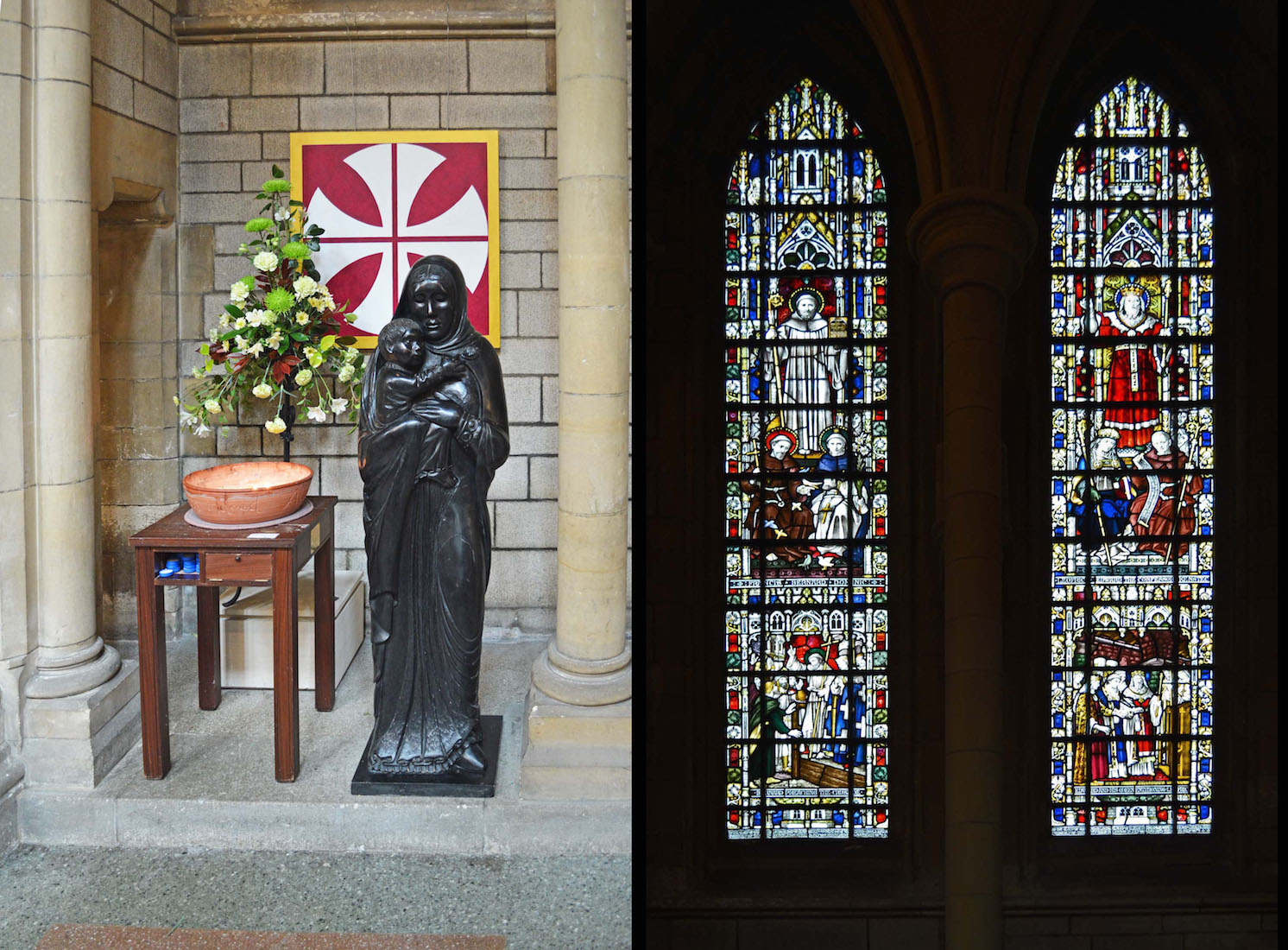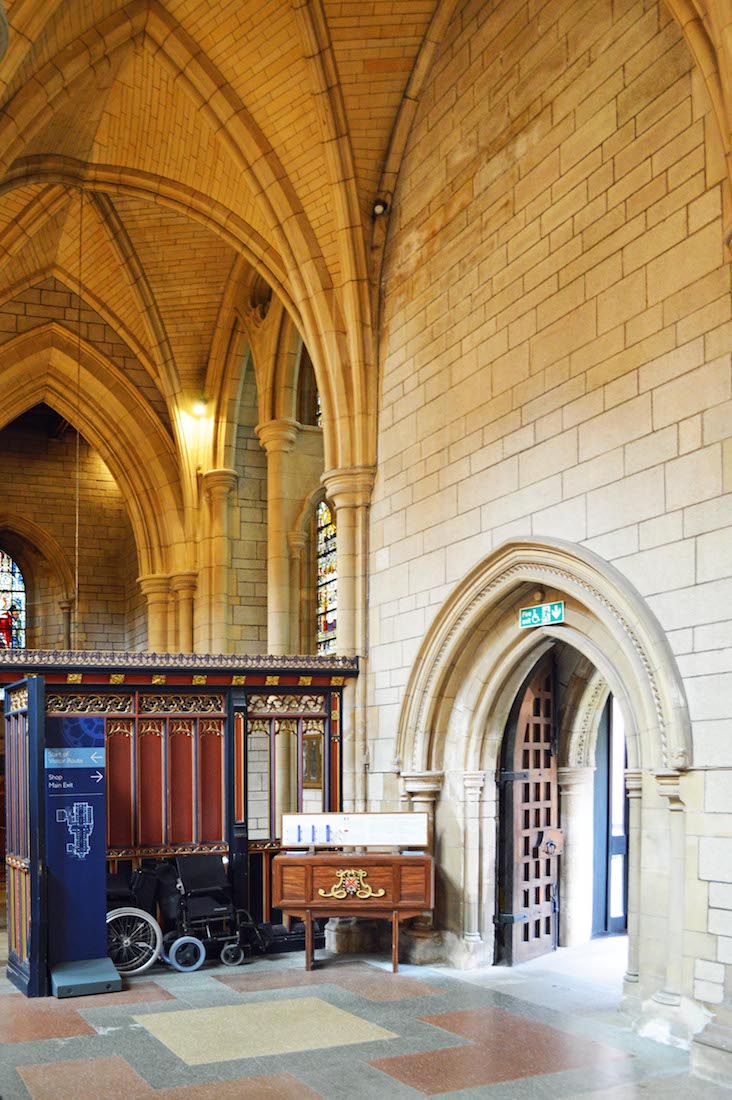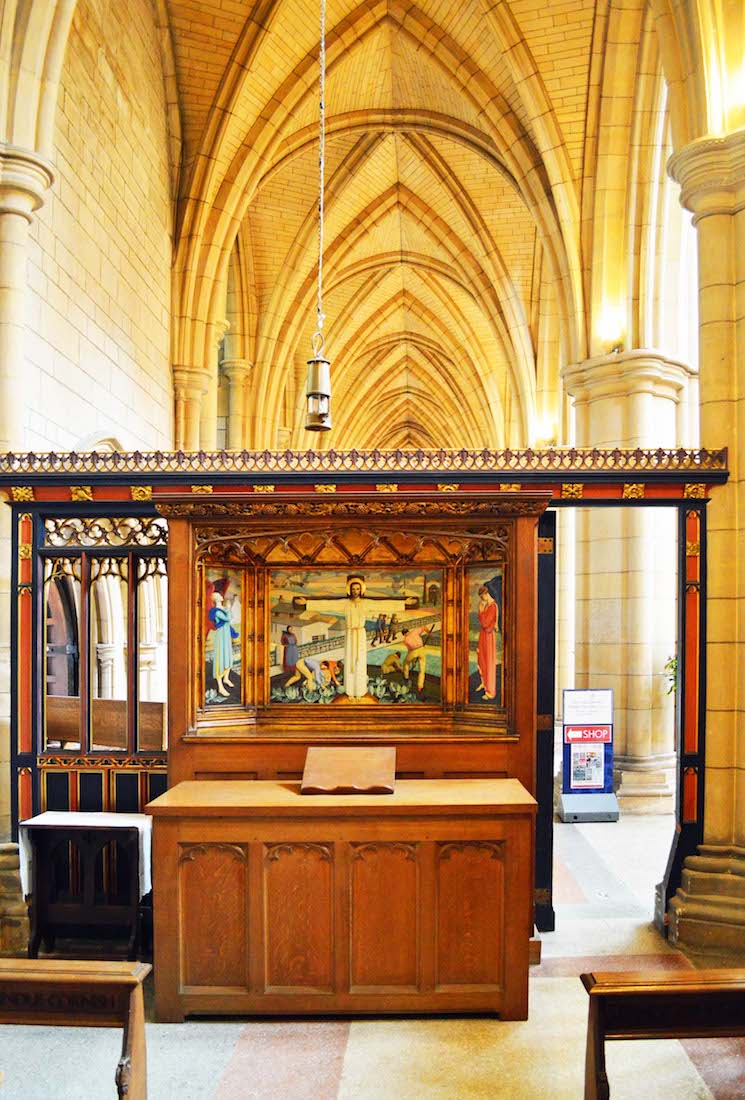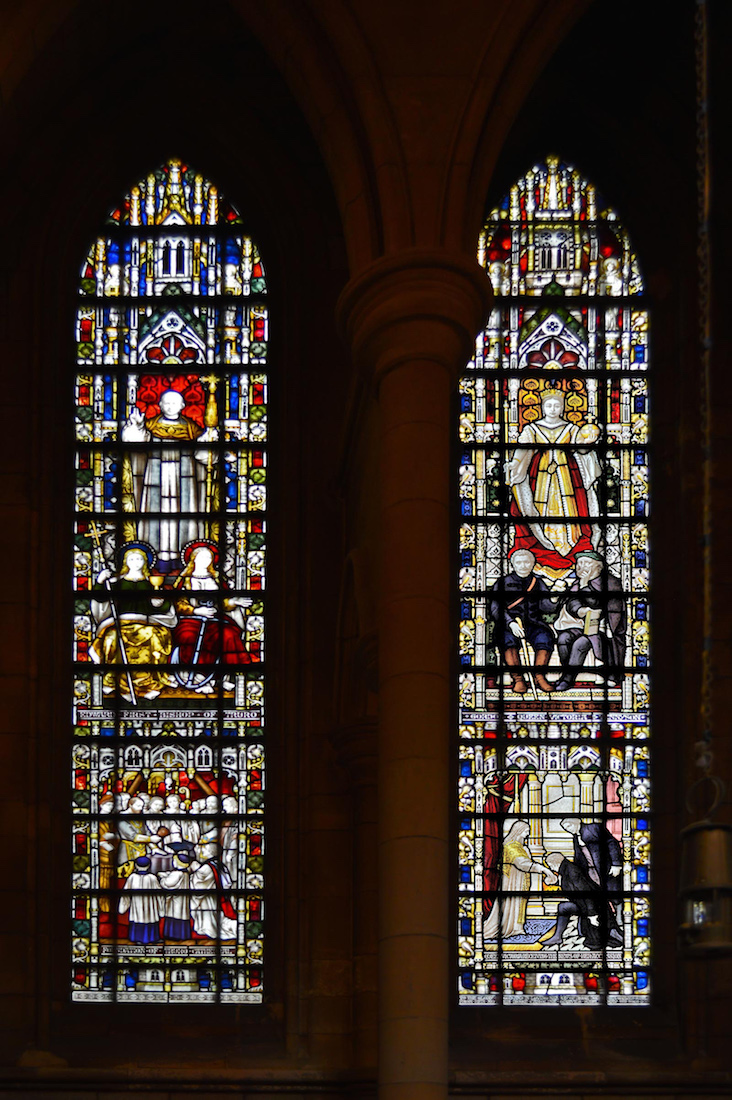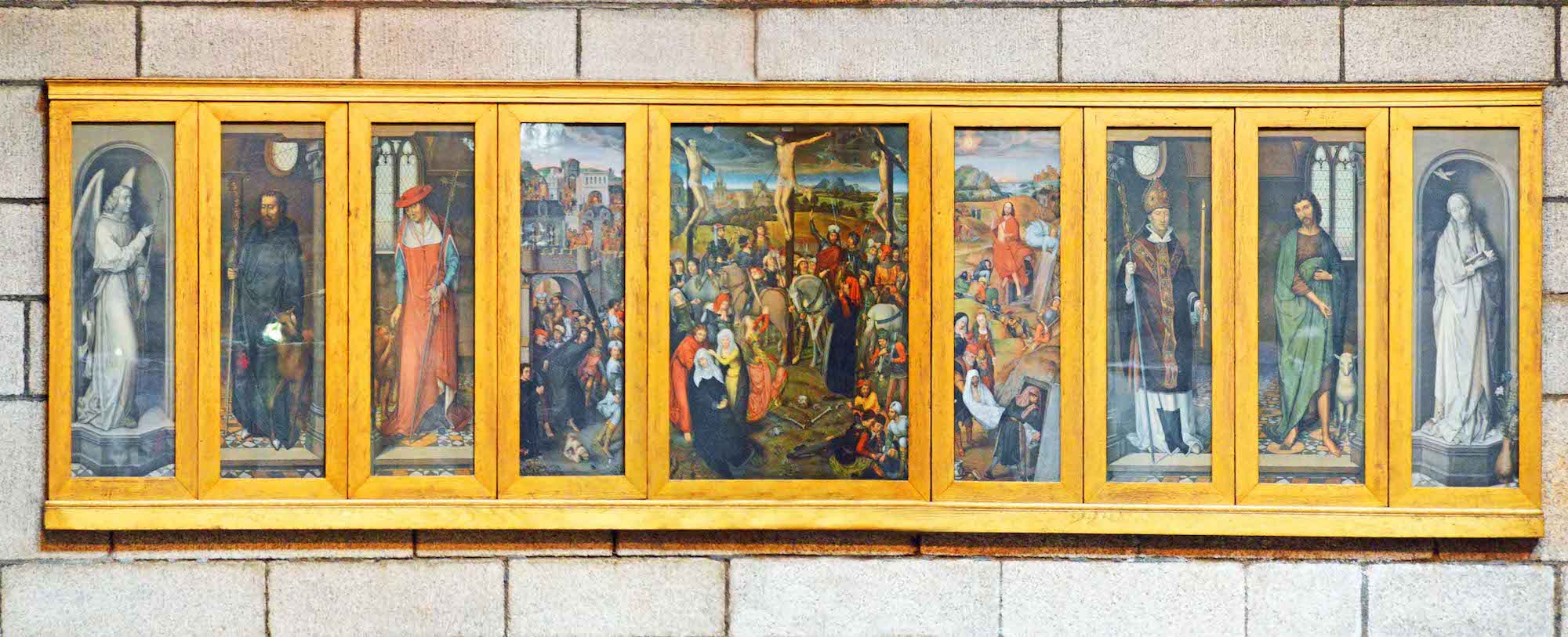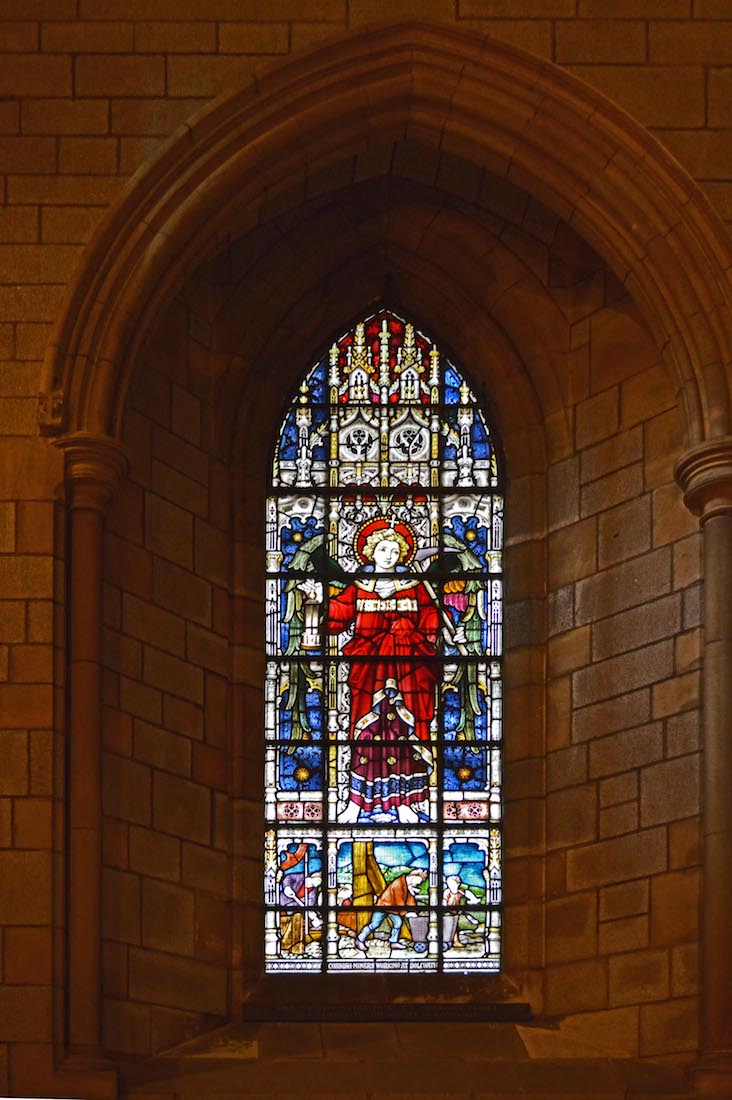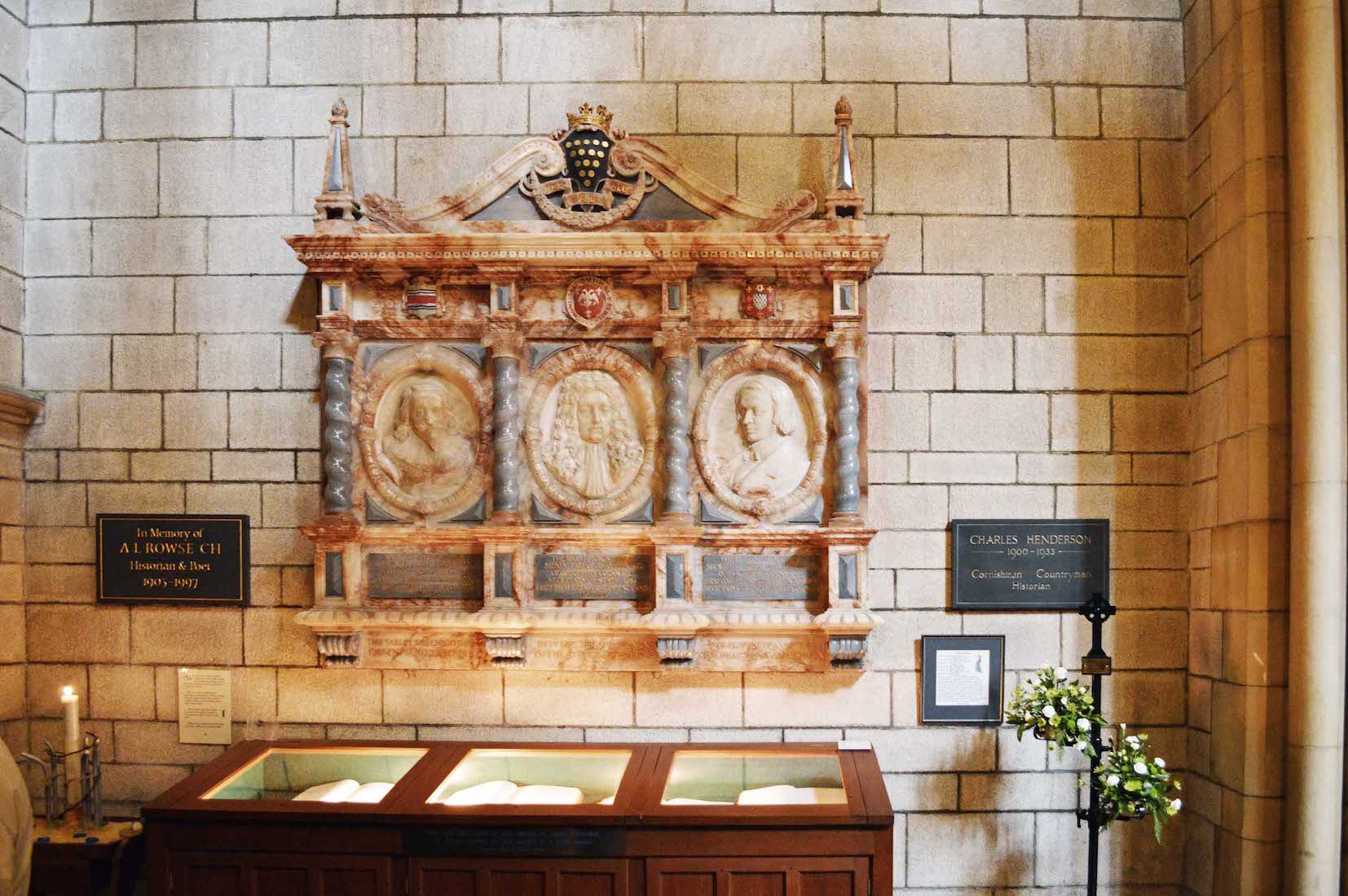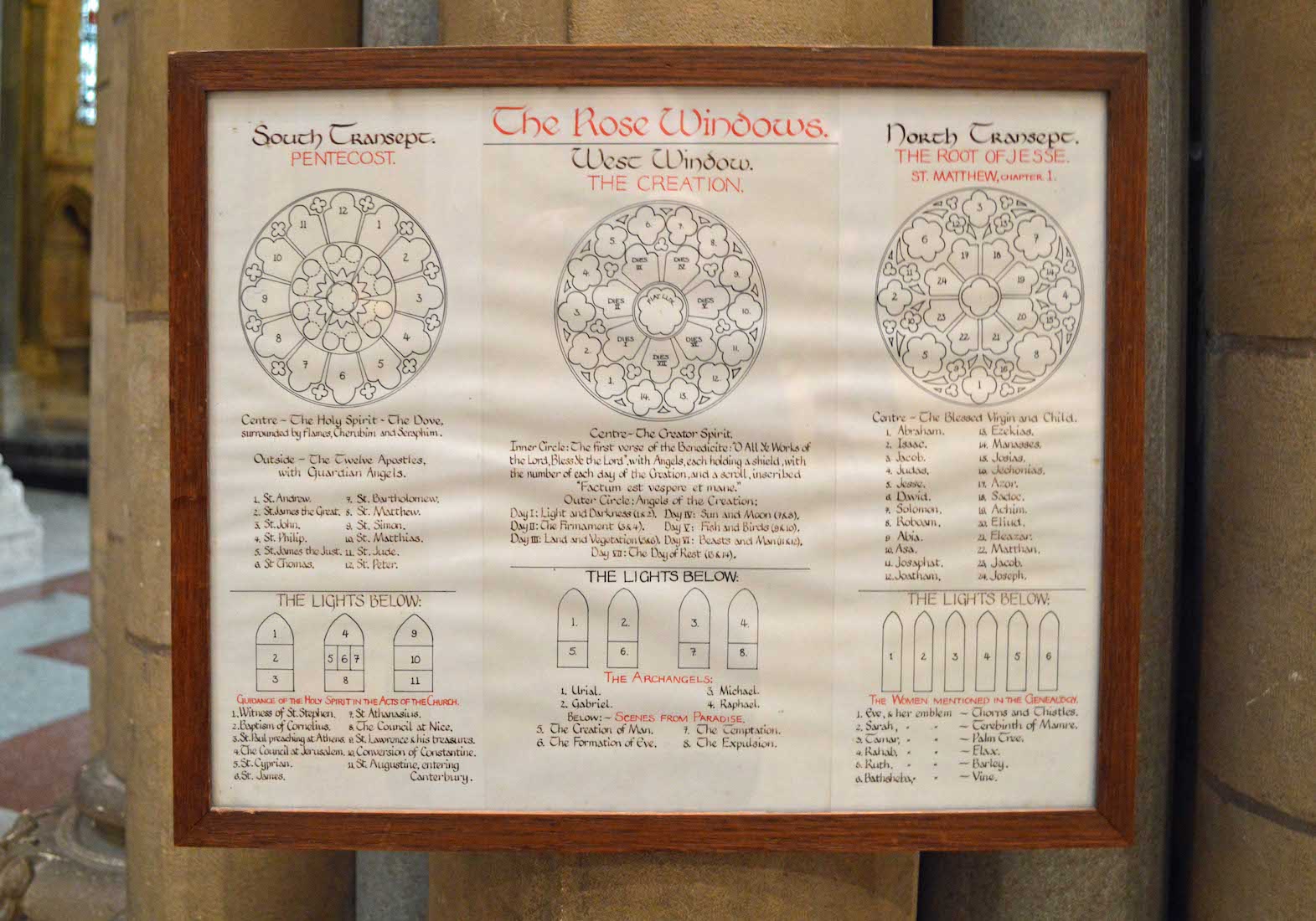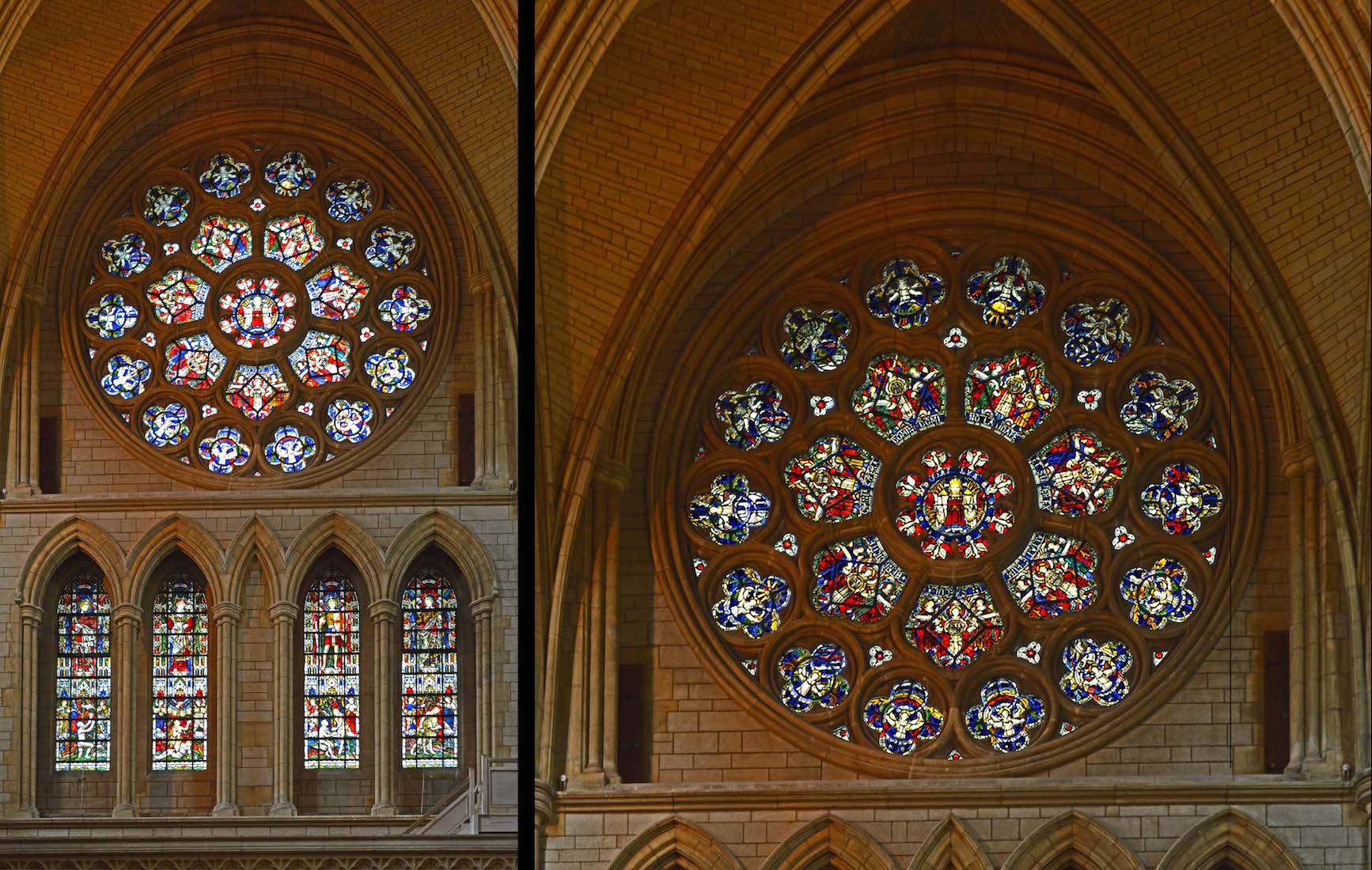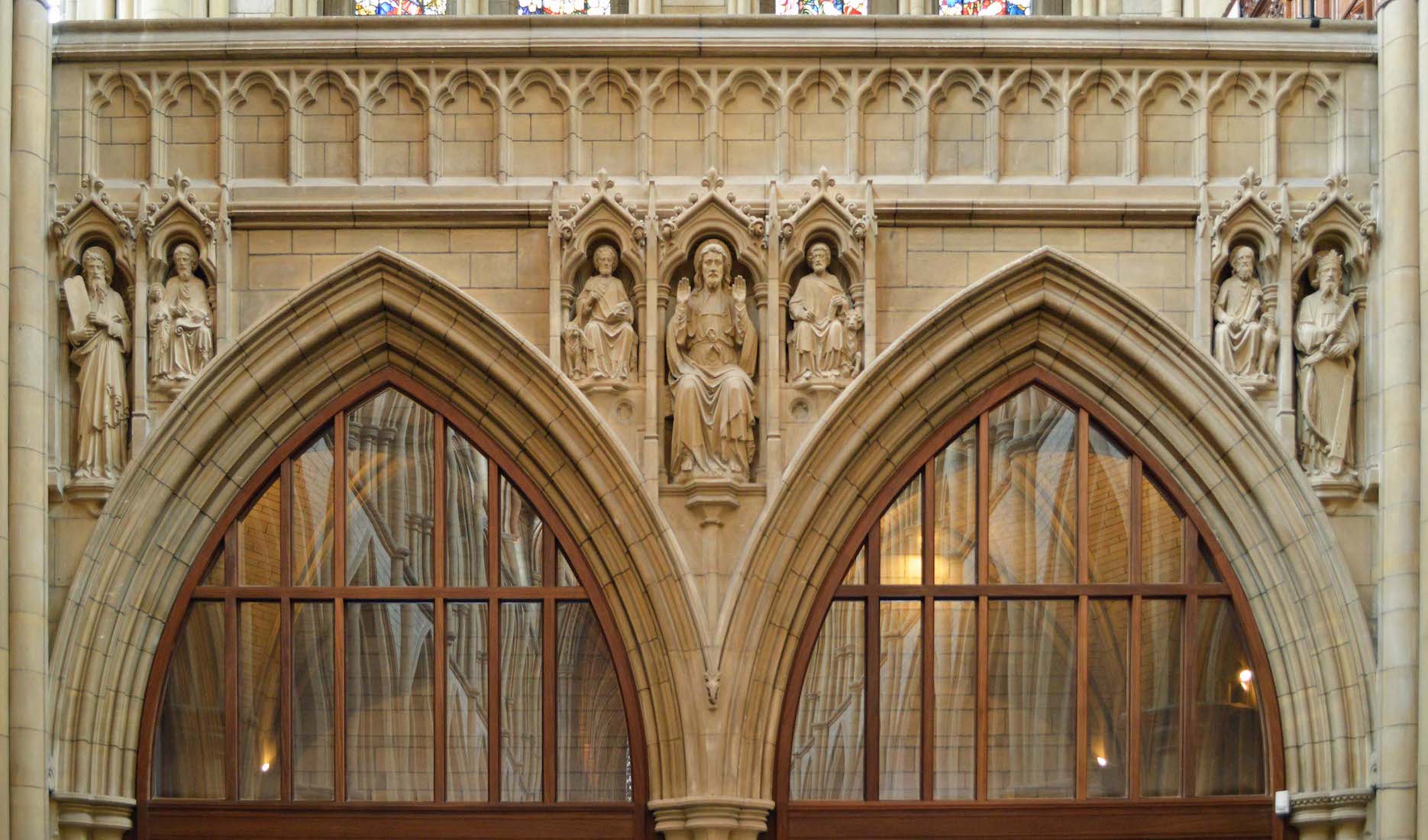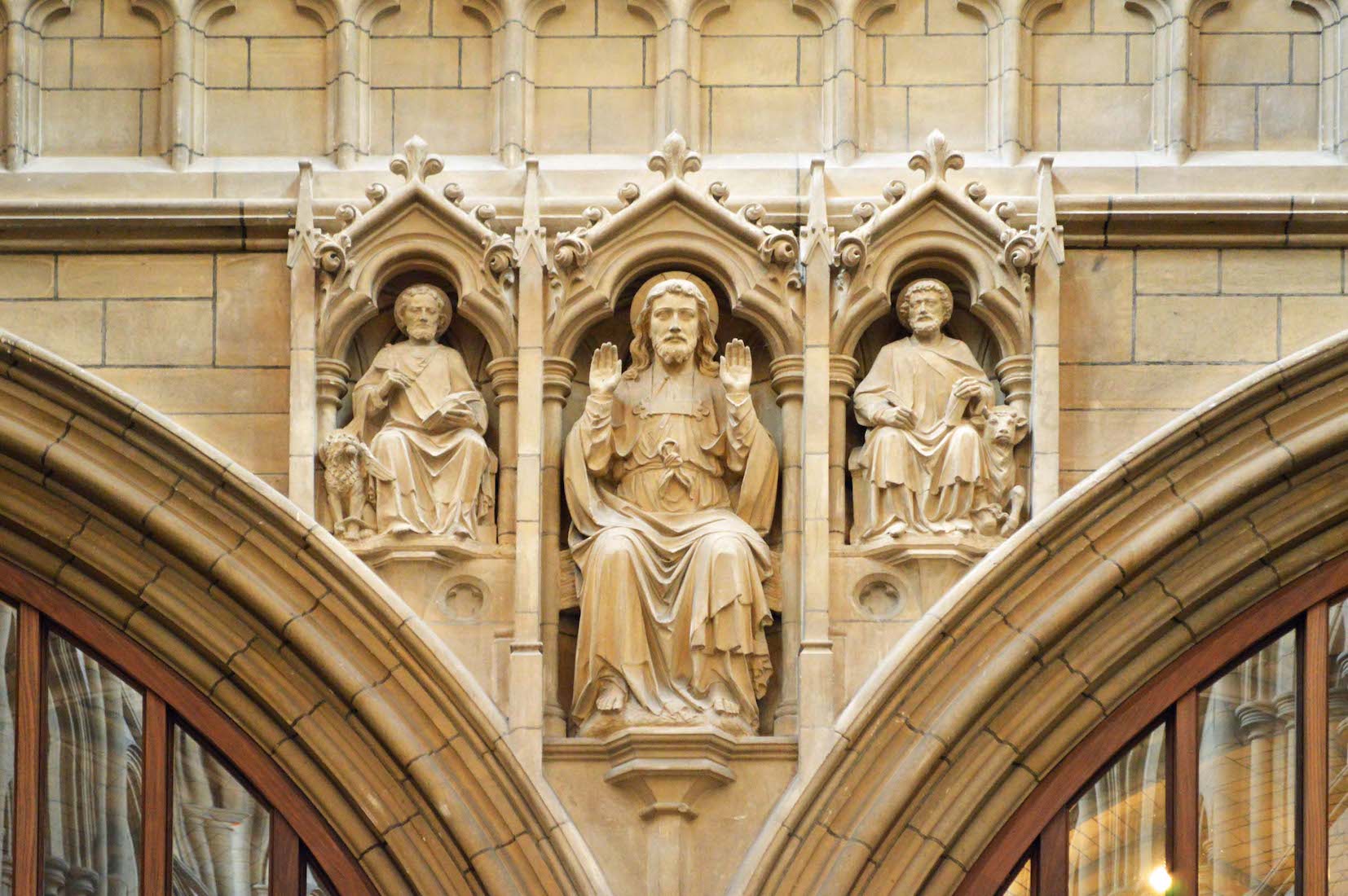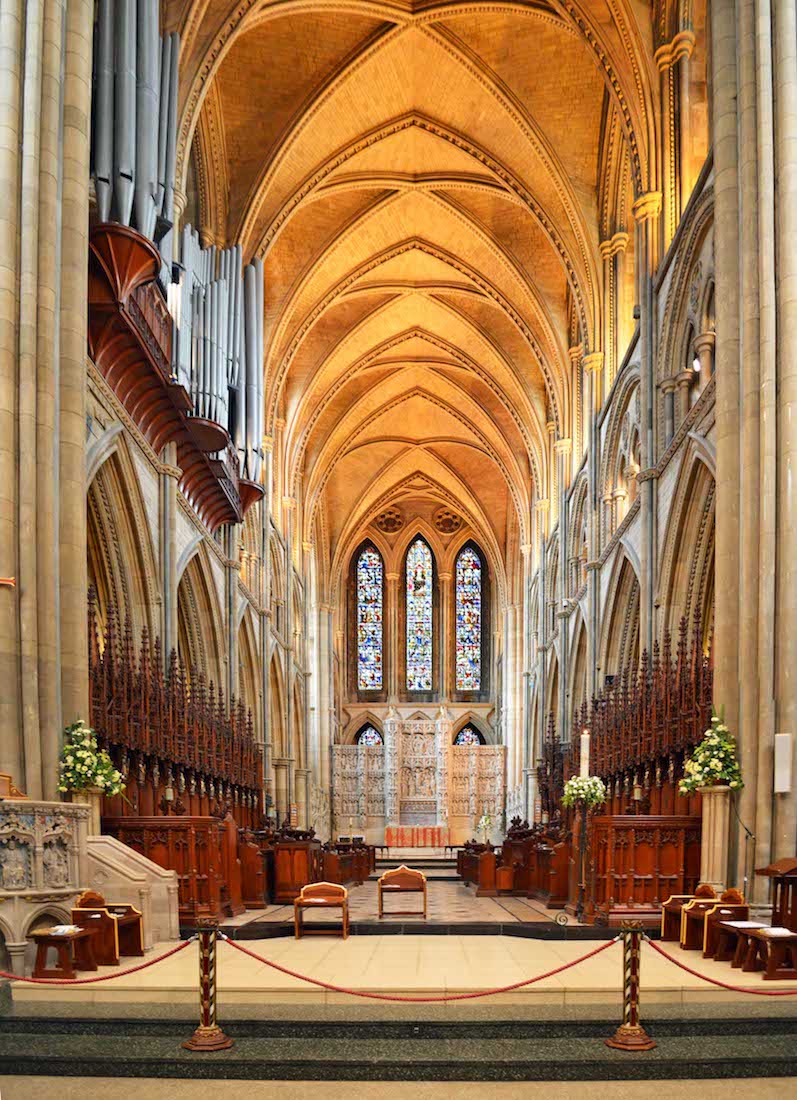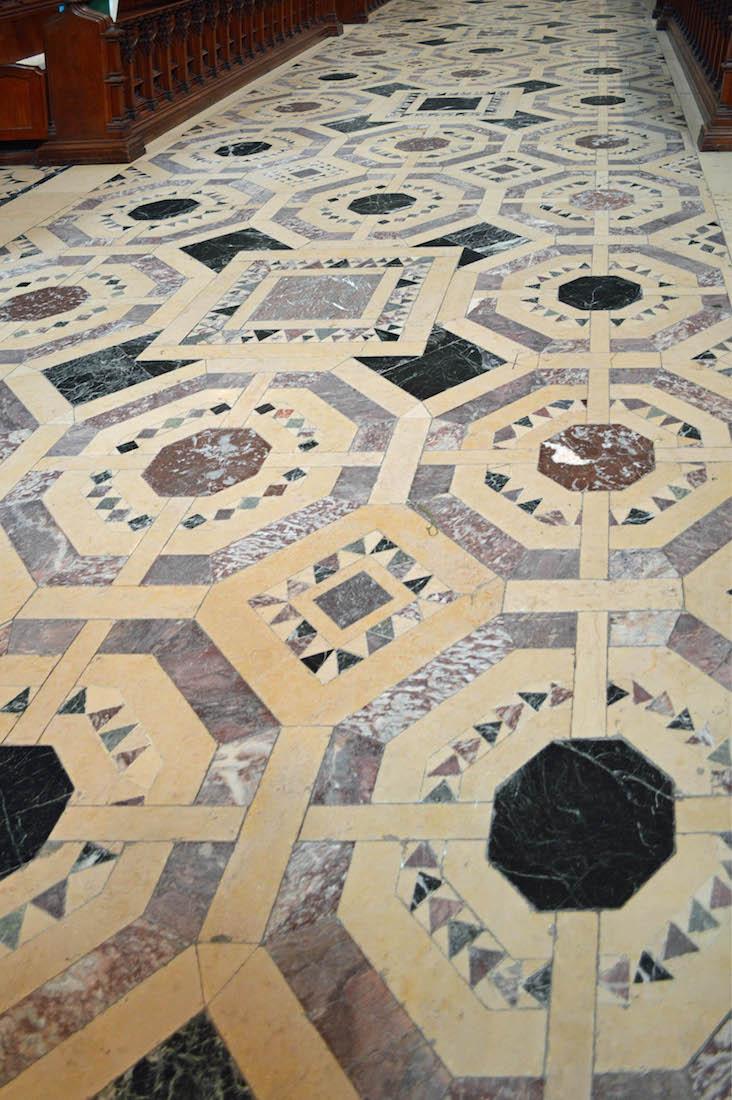81. CAFETERIA II
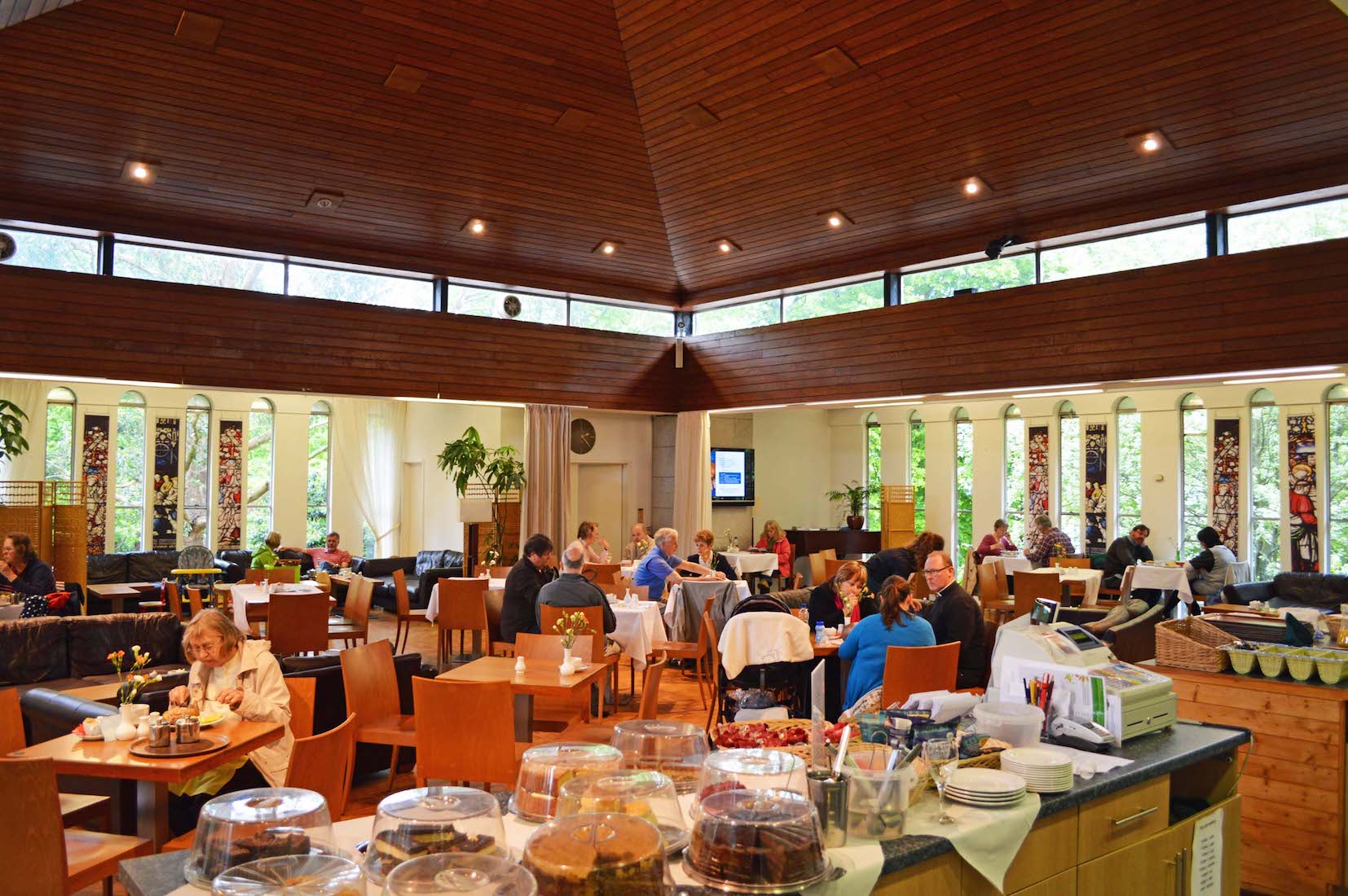
Another view of the restaurant with its spacious interior and attractive leafy views. PLAN
82. NORTH NAVE WINDOW, LECTERN
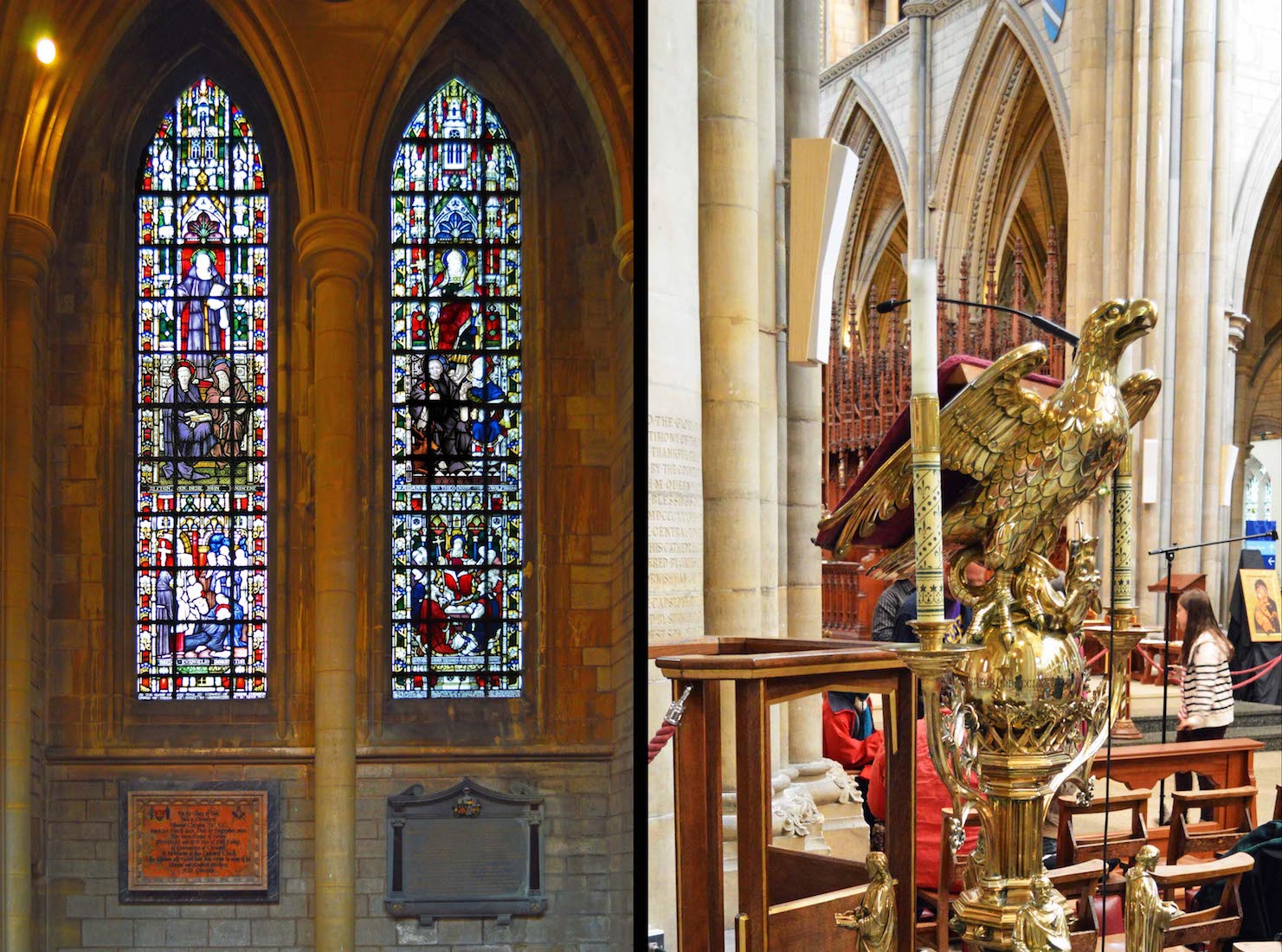
Suitably refreshed, we return to the North nave aisle, and the first windows. The windows show from left: • Bl. Alcun, the Venerable Bede, St John Damascene, and below, Bede sharing gospel • St Aidan, St Theodore, St Wilfrid, and below, Theodore teaching. • Close by is the brass eagle lectern. The eagle lectern is a common sight in Anglican churches, but this lectern is rather special. The eagle has a small dragon in its talons, and below the figures of the four Evangelists give their support.
83. NORTH NAVE BLACK MADONNA, WINDOWS II
Shown at right is the next pair of lancets. These portray (from left) • St Francis, St Bernard and St Dominic, with below, Bernard preaching the Crusade. • Leofric (Medieval Bishop of Exeter and probably a native of Cornwall), Edward the Confessor and Kenstec (Medieval Bishop of Cornwall), and below, Edward and his Queen enthroning Leofric. •• Truro Cathedral is dedicated to the Blessed Virgin Mary. This black ebony sculpture in a side niche of the North nave aisle, depicting Mother and Child, is perhaps one of the most evocative pieces in the Cathedral. The Child is reaching towards a fish symbol on the Madonna’s shoulder.
84. NORTH NAVE WINDOWS III
We continue up the North nave aisle, admiring the windows. From the left: • At top, Keble, Martyn, Maurice and below Martyn before the Moulvies (Muslim lawyers) • Newton, Bishop Butler, Handel, and below, Bishop Butler presenting The Anthology to Queen Caroline. •• From left, • Lancelot Andrewes, Richard Hooker, Francis Bacon, and below we see Richard Hooker preaching at St Paul’s Cross, London in 1581. • John Wycliffe, Archbishop Thomas Cranmer, Miles Coverdale, and below, the King acceding to Cranmer’s request that the Bible should be read in English in all churches. •• . Here we see (from left): • Lewis IX, Joan of Arc, St Catherine of Siena, and below, the Coronation of Charles VII • Edward I, Stephen Langton, and Bishop Grosseteste, and below, Signing of the Magna Carta.
85. CATHEDRAL SIGNS
At the West end of the North nave aisle we come to the shop entrance, and these interesting signs, with Bible verses attached to Cathedral photos. The verses are: Go and make disciples of all the nations ... baptizing them in the name of the Father the Son and the Holy Spirit; Your word is a lantern to my feet ... and a light upon my path; Take, eat, this is my body ... this is my blood of the new covenant; I was glad when they said to me ... ‘Go to the house of the Lord’; How awesome is this place ... this is the house of God and the gate of heaven; God so loved the world ... that He gave His only Son.
86. CATHEDRAL SHOP ENTRY
To our right now is the entrance to a small Cathedral shop. Straight ahead are two small chapels – the Jesus Chapel, and the Chapel of Unity and Peace. In the centre is a box for donations. Some visitors feel that a visit to a church should be free, but Cathedrals are also historic, heritage buildings which require a lot of money to maintain. It is a privilege to be able to help!
87. JESUS CHAPEL
The Jesus Chapel has a small altar with its back to the nave. Behind the altar is a simple triptych. On one side is an angel worshipping, on the other, an angel in prayer. The central panel shows a glorified Christ against a cross, set in a presumably Cornish rural setting. The Jesus Chapel and the Chapel of Unity and Peace are reserved for quiet and prayer throughout the day.
88. JESUS CHAPEL WINDOW
On the North wall of the Jesus Chapel is a stained glass window. The left lancet shows Edward (Benson), First Bishop of Truro, and below is a scene of the Foundation of Truro Cathedral. The lancet to the right depicts Gordon, Queen Victoria and Tennyson, and below, Queen Victoria welcomes the news of her accession.
89. JESUS CHAPEL GALLERY
Along the North wall of the Jesus Chapel is a panel of nine framed paintings. There is probably an explanation somewhere, but the only painting which is easy to interpret is the large central depiction of the Crucifixion.
90. UNITY CHAPEL WINDOW
The Jesus Chapel adjoins and runs into the Chapel of Unity and Peace in the North West corner of the Cathedral. On the West wall is a single lancet window in which the main frame is an angel dressed in red and carrying a miner’s pick. The panels at the bottom of the window show a mining scene. In fact, this is the Dolcoath Miners’ Window, commemorating a serious accident at the Dolcoath Mine in Cornwall in 1893, in which seven men were killed..
91. UNITY CHAPEL STATESMEN MEMORIAL
The monument at right is in memory of Cornish statesmen: Sir John Elliot MP (1632), The Rt Hon Sidney Lord Godolphin (1712), and Rt Hon Sir William Molesworth Bt (1855).
92. WEST ROSE WINDOW INFORMATION
This sign gives an overview of the three rose windows in Truro Cathedral. The main rose window features ‘The Creation’; the South transept ‘Pentecost’, and the North transept ‘The Root of Jesse’.
93. WEST ROSE WINDOW
The top of the West wall features this beautiful rose window, celebrating God the Father, the first member of the Trinity. Below the rose window are four lancet windows in two pairs. This rose window is one in the set of three such rose windows we have now seen, celebrating the three Persons of the Trinity. The black framed squares and circles form a unifying link with the other windows.
94. BALCONY BELOW WEST WINDOWS
Below the central West windows and above the West doors is a balcony featuring some lovely carved figures. Christ has the central position. Then at extreme left is Moses holding a tablet of the Law, and distinguishable by the horns which arose from a mistranslation of the Old Testament text. Next are the Four Evangelists with their symbols: from left, Matthew (angel), Mark (winged lion), Luke (ox or bull) and John (eagle). Finally at extreme right is King David with his crown, sceptre and lyre.
95. BALCONY DETAIL
A closer view of the glorified Christ, with Mark on his left and Luke on his right.
96. QUIRE
In our exploration of this wonderful Cathedral, there just remains the central Quire and Chancel. From the crossing looking East, the Quire stalls bound our view on either side, with the organ pipes at upper left. Above is the fine ribbed vaulting of the ceiling. Straight ahead of us is the High Altar in front of the beautiful reredos screen, and beyond that the colourful Great East Windows.
97. QUIRE FLOOR TILES
Looking to the quire and sanctuary, there are some treats in store here! But first we notice the attractive tiled flooring..
98. ORGAN
The Father Willis Organ of 1887 is widely regarded as one of the finest instruments in the country. Few people speak of this organ without the use of superlatives. The organ was built in 1887 in London and arrived in Cornwall by boat. There is no doubt that Willis was one of the greatest organ builders there has ever been. At Truro the instrument has survived tonally intact – in fact this is unique in any cathedral.
99. QUIRE STALLS
On the right hand side is the paschal candle, and behind, the right tiers of beautifully carved quire stalls. It is a joy to sit here alongside the quire at Evensong.
100. QUIRE STALL FIGURES
One of the delights of cathedral quire stalls is discovering the little carved figures. Many of these early workmen had a great sense of creativity and humour, as well as the ability to express it with their handiwork. • I am very fond of cathedral angels like these! However, most Biblical references to angels seem to indicate that they are male ... .


